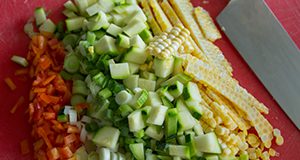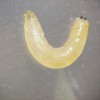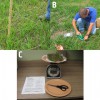 In recent years, many people have become interested in developing small food businesses. Using county kitchens to make food products for sale may seem very attractive. However, because of different local, state, and federal regulation requirements, there may be some confusion and unresolved conflicts among different parties as to the legalities and practicalities involved. This 3-page fact sheet provides guidelines and advice for Florida Extension personnel to use when determining the appropriate usage for their kitchen facilities, based on a situation in one Florida county. The publication covers utilization, roles and responsibilities, and potential liability issues relevant to the use of county kitchens, providing some potential solutions to conflicts for all parties. Written by Amarat Simonne, Tim Wilson, Geralyn Sachs, Joanne Cooper, Brenda Morris, Steven von Bodungen, and Liz Felter, and published by the UF Department of Family, Youth and Community Sciences, August 2016.
In recent years, many people have become interested in developing small food businesses. Using county kitchens to make food products for sale may seem very attractive. However, because of different local, state, and federal regulation requirements, there may be some confusion and unresolved conflicts among different parties as to the legalities and practicalities involved. This 3-page fact sheet provides guidelines and advice for Florida Extension personnel to use when determining the appropriate usage for their kitchen facilities, based on a situation in one Florida county. The publication covers utilization, roles and responsibilities, and potential liability issues relevant to the use of county kitchens, providing some potential solutions to conflicts for all parties. Written by Amarat Simonne, Tim Wilson, Geralyn Sachs, Joanne Cooper, Brenda Morris, Steven von Bodungen, and Liz Felter, and published by the UF Department of Family, Youth and Community Sciences, August 2016.
http://edis.ifas.ufl.edu/fy1469
Tag: Tim Wilson
Bermudagrass Stem Maggot: A New Pest in Florida
 Bermudagrass is a dominant hay crop in Florida. Now, hay producers are facing a new emerging pest problem in bermudagrass and stargrass production fields. The bermudagrass stem maggot, is a new exotic invasive fly. It was first discovered damaging bermudagrass pasture and hay fields in Georgia. The identification of the fly was the first record of this species in North America, and it has the potential to become a serious pest of bermudagrass and stargrass in Florida. This 2-page fact sheet was written by Ann Blount, Tim Wilson, Jay Ferrell, Russ Mizell, and Jonael Bosques, and published by the UF Department of Agronomy, June 2014.
Bermudagrass is a dominant hay crop in Florida. Now, hay producers are facing a new emerging pest problem in bermudagrass and stargrass production fields. The bermudagrass stem maggot, is a new exotic invasive fly. It was first discovered damaging bermudagrass pasture and hay fields in Georgia. The identification of the fly was the first record of this species in North America, and it has the potential to become a serious pest of bermudagrass and stargrass in Florida. This 2-page fact sheet was written by Ann Blount, Tim Wilson, Jay Ferrell, Russ Mizell, and Jonael Bosques, and published by the UF Department of Agronomy, June 2014.
http://edis.ifas.ufl.edu/ag384
Estimando la Cantidad de Forraje en Campos de Heno y Potreros
 El forraje sirve como fuente primaria de nutrientes para la industria ganadera en Florida. El uso eficiente de esta fuente nutricional es crítico para la supervivencia de los agricultores y rancheros de dicho estado. El estimar la cantidad de forraje en potreros puede proveer información útil a la hora de tomar decisiones acerca del manejo de nuestros recursos. Debe de haber suficiente material en el predio para justificar el costo de utilizar el equipo para cosechar (por ejemplo, precio de compra del equipo, renta, costo del combustible a invertirse, y el costo de la mano de obra). Sin esta información, el predio debe ser sometido a pastoreo. Esta publicación contiene las instrucciones para la implementación de un método simple que nos permite determinar la cantidad aproximada de forraje en campos de heno y potreros.This 2-page fact sheet was written by T. Wilson, C. Sanders, J. Breman, y L. Sollenberger. Traducido por J. Bosques, and published by the UF Department of Agronomy, January 2014.
El forraje sirve como fuente primaria de nutrientes para la industria ganadera en Florida. El uso eficiente de esta fuente nutricional es crítico para la supervivencia de los agricultores y rancheros de dicho estado. El estimar la cantidad de forraje en potreros puede proveer información útil a la hora de tomar decisiones acerca del manejo de nuestros recursos. Debe de haber suficiente material en el predio para justificar el costo de utilizar el equipo para cosechar (por ejemplo, precio de compra del equipo, renta, costo del combustible a invertirse, y el costo de la mano de obra). Sin esta información, el predio debe ser sometido a pastoreo. Esta publicación contiene las instrucciones para la implementación de un método simple que nos permite determinar la cantidad aproximada de forraje en campos de heno y potreros.This 2-page fact sheet was written by T. Wilson, C. Sanders, J. Breman, y L. Sollenberger. Traducido por J. Bosques, and published by the UF Department of Agronomy, January 2014.
http://edis.ifas.ufl.edu/ag379
Estimating Amount of Forage in Hay Fields and Pastures (SSAGR360/AG369)
 Forage serves as the primary source of nutrients for livestock in Florida, and efficient use of forage is critical to the livelihood of Florida farmers and ranchers. Estimating the amount of forage in a pasture can provide useful information when making management decisions. There must be enough material in the field to justify the cost of using harvesting equipment; otherwise, the area should be grazed. This 2-page fact sheet contains instructions for a simple method to determine the approximate amount of forage in hay fields and pastures. Written by T. Wilson, C. Sanders, J. Breman, and L. Sollenberger, and published by the UF Department of Agronomy, March 2012.
Forage serves as the primary source of nutrients for livestock in Florida, and efficient use of forage is critical to the livelihood of Florida farmers and ranchers. Estimating the amount of forage in a pasture can provide useful information when making management decisions. There must be enough material in the field to justify the cost of using harvesting equipment; otherwise, the area should be grazed. This 2-page fact sheet contains instructions for a simple method to determine the approximate amount of forage in hay fields and pastures. Written by T. Wilson, C. Sanders, J. Breman, and L. Sollenberger, and published by the UF Department of Agronomy, March 2012.
http://edis.ifas.ufl.edu/ag369
Converting the Beef Cow Herd to a Controlled Breeding Season (AN267)
 Implementing a controlled breeding season to manage the length of the calving season is a cost-effective management practice. This 4-page fact sheet describes a 3- to 4-year conversion program beef cattle producers can follow. Written by Tim Wilson, Cindy Sanders, Mark Warren, Matt Hersom, and Curt Lacy, and published by the UF Department of Animal Science, August 2011.
Implementing a controlled breeding season to manage the length of the calving season is a cost-effective management practice. This 4-page fact sheet describes a 3- to 4-year conversion program beef cattle producers can follow. Written by Tim Wilson, Cindy Sanders, Mark Warren, Matt Hersom, and Curt Lacy, and published by the UF Department of Animal Science, August 2011.
http://edis.ifas.ufl.edu/an267